Graphene nanoribbons
Graphene nanoribbons (GNR) are one-dimensional structures like nanotubes are. They are strips of graphene presenting a long aspect ratio (length over width ratio). Graphene nanoribbons can be produced by several ways, among which: lithography (cutting from a graphene sheet), bottom-up (organic chemical synthesis), and unzipping carbon nanotubes (longitudinal opening by chemical means). The electronic properties of the nanoribbons strongly depend on the orientation, the quality and the termination of the edges, and they vary the width of the structure.
Two types of ideal graphene nanoribbons, called zigzag and armchair, are often referred to. Their denomination comes from the shape of the edges that are supposed to follow one of the basic crystallographic orientations of the underlying graphene lattice. The dangling bonds at the free edges may either reconstruct or be saturated with chemical species, the simplest being atomic hydrogen.
 |
 |
The two figures above illustrate a zigzag (left) and an armchair (right) graphene nanoribbon. In each case, H atoms (black balls) are attached on the free edges. The width of a zigzag nanoribbon is specified by the number N of zigzag chains parallel to the edges, here 10. For an armchair nanoribbon, the width is specified by the number N of C atoms along zigzag chains normal to the edges, here 15.
According to state-of-the-art band structure calculations, zigzag and armchair nanoribbons are semiconductors [1]. The band gap is of the order of 1-3 eV for a 1-nm wide nanoribbon, depending on its exact structure, and it decreases with increasing width. Spin interactions are responsible for the non-zero bang gap value of the zigzag nanoribbons [2]. There is a strong spin polarization at both edges, with opposite signs on the two edges (antiferromagnetic configuration).
- "Quasiparticle energies and band gaps of graphene nanoribbons" L. Yang, C.H. Park, Y.W. Son, M.L. Cohen, and S.G. Louie, Phys. Rev. Lett. 99 (2007) 186801 [DOI: 10.1103/PhysRevLett.99.186801].
- "Electronic structure and magnetic properties of graphitic ribbons" L. Pisani, J.A. Chan, B. Montanari, and N.M. Harrison, Phys. Rev. B 75 (2007) 064418 [DOI: 10.1103/PhysRevB.75.064418].